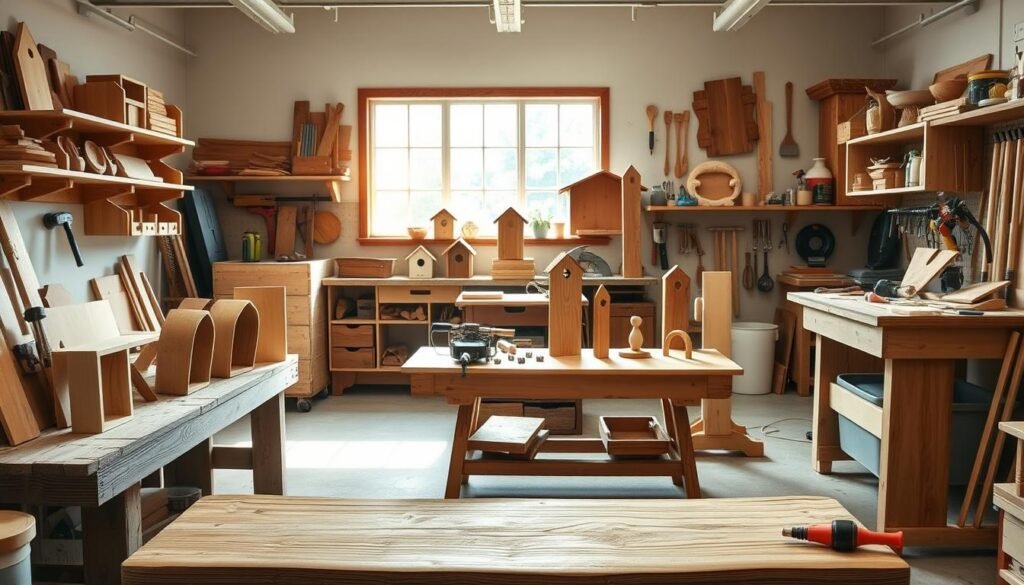A workshop without a dust collection system is dangerous. Dust and debris can cause serious respiratory problems. It’s vital to have a dust collection system for a clean and safe space.
Installing a dust collection system improves air quality. It also lowers the risk of dust inhalation. This guide will help you set up a dust collection system in your shop. It will make your workspace healthier and more productive.
A good dust collection setup keeps you healthy and boosts workshop efficiency. It’s a key investment for woodworkers and craftsmen.
The Hidden Dangers of Workshop Dust
Many woodworkers don’t realize the dangers of workshop dust. It can lead to serious respiratory problems like asthma. This is because the dust particles become airborne during woodworking.
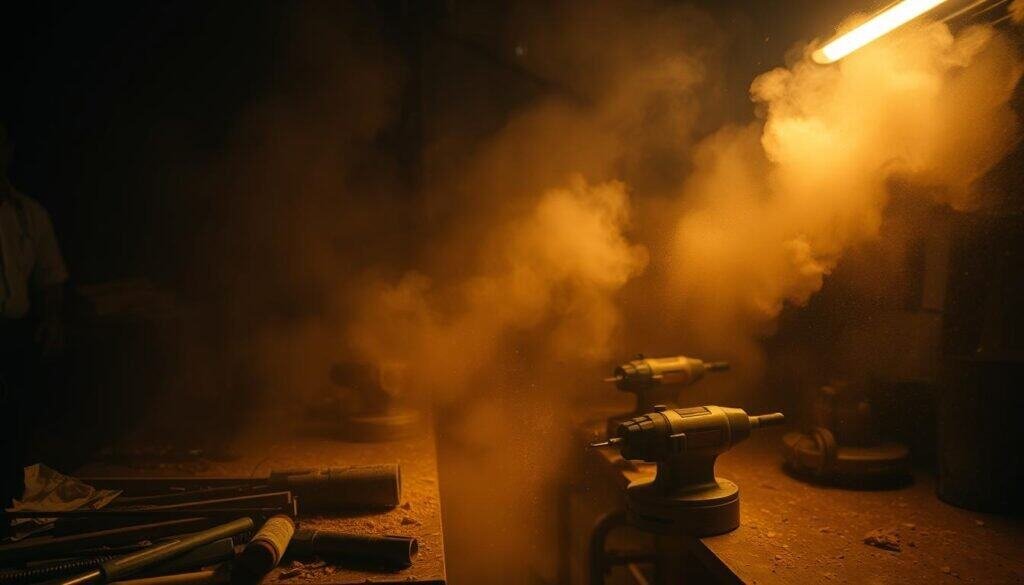
Dust in the workshop is not just a health risk. It also increases the chance of fires. Fine dust can ignite easily, leading to fires or explosions. Plus, dust buildup makes equipment less efficient and raises maintenance costs.
Managing workshop dust is key to safety. A good dust collection system is essential. It reduces airborne dust, making the workshop safer and healthier for woodworkers.
Woodworkers can protect their health and improve safety by managing dust. Using dust collection system tips can make the workshop cleaner and more efficient. This way, woodworkers can work in a safer and more productive environment.
Types of Dust Collection Systems for Different Shop Sizes
A good dust collection system is key for any workshop, big or small. It keeps the air clean, makes work safer, and boosts productivity.
In smaller workshops, a compact system is usually the best choice. These systems are space-saving and efficient, perfect for tight spaces.
Portable Solutions for Limited Workshops
Portable dust collectors are great for small to medium-sized workshops. They’re easy to move and connect to many tools. This makes them handy when your tools and workstations change often.
When setting up a dust collection system, think about your workshop’s layout and tools. It’s important to size the system right for your needs and keep it in good shape.
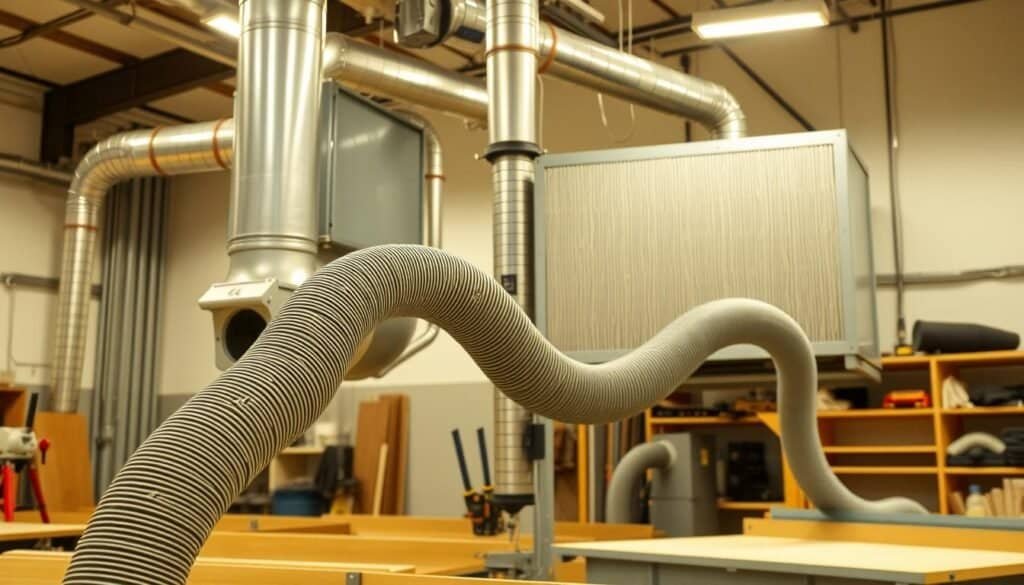
Bigger workshops need more advanced systems, like central ones that handle lots of dust. These can be tailored to fit your workshop’s needs, including adding multiple dust collection points.
No matter the workshop size, following best dust collection practices is vital. This means keeping the system clean, maintaining it regularly, and making sure all tools are connected.
Assessing Your Workshop’s Dust Collection Needs
To manage workshop dust well, you need to know what you need. Look at your workshop’s layout, the tools you use, and how much dust you make. This will tell you what a dust collection system should do for you.
First, map out your workshop. Find where dust is made and what tools are used there. For a DIY dust collection system, think about your workshop’s size and the dustiest tools.
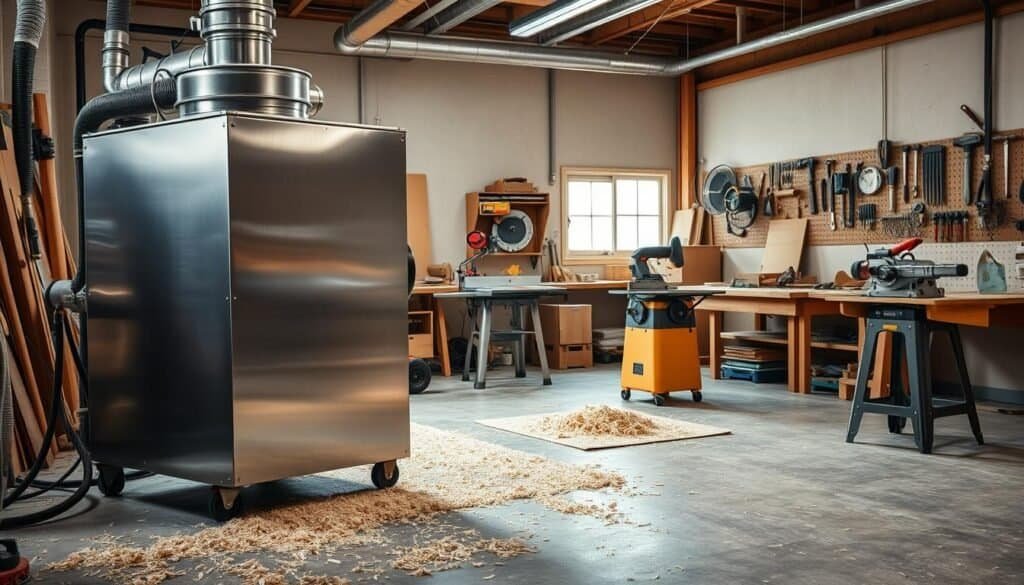
Then, think about setting up a dust collector. Pick the right one for your shop, plan the ductwork, and make sure it fits your workshop’s size. These steps will help you set up a good dust collection system.
Knowing your workshop’s needs lets you create a dust collection system that works well. It will make your workspace cleaner and healthier.
Planning Your Dust Collection System Layout
Designing a good dust collection system layout is key to making your shop more efficient. A well-planned layout helps catch dust and debris better. This improves air quality and cuts down on cleanup time.
When setting up your dust collection system, think about your workshop’s needs. Consider the DIY tools and homemade equipment you use. Adding a shop vac dust collector diy can make your system work better.
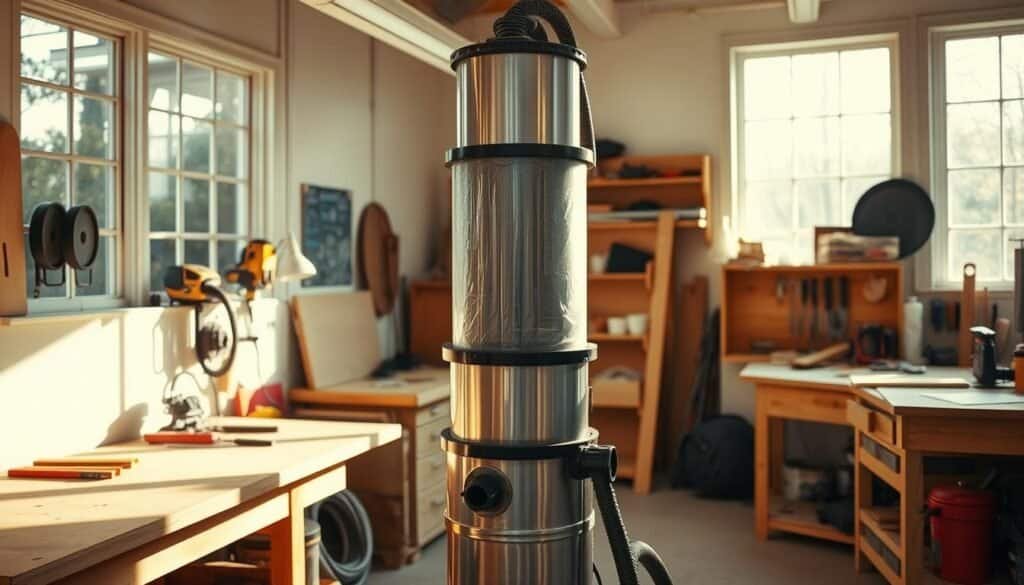
It’s important to avoid common mistakes in dust collection system design. One big error is using ducts that are too small. This can lower airflow and make the system less effective. Another mistake is poor design, which can let dust and debris build up in some spots.
Avoiding Common Layout Mistakes
To steer clear of these mistakes, plan your system’s layout carefully. Choose the right duct size and material. Make sure the system is designed well and works well with your DIY tools.
By spending time on planning, you can make a dust collection system that’s efficient and meets your workshop’s needs.
Selecting the Right Dust Collector for Your Shop
Finding the right dust collector is key to a clean and safe workshop. It’s important for all woodworking tasks, from mitre saw to bandsaw projects. The right one can make a big difference in your shop’s cleanliness and safety.
Dust collectors vary, including single-stage, two-stage, and cyclone models. Each has its own benefits. Single-stage dust collectors are good for small to medium-sized workshops. They’re cost-effective for basic needs. Two-stage dust collectors are better for larger workshops or heavy-duty tools, providing more efficient dust collection.
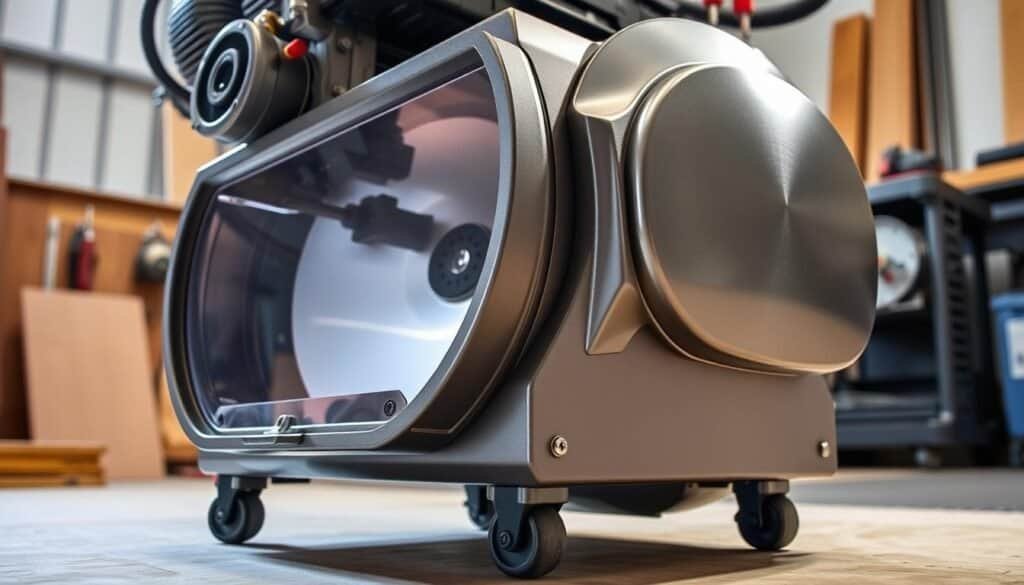
Think about the tools you’ll use with your dust collector. For mitre saws, look for one that captures fine dust well. For bandsaw projects, a strong suction power is needed to remove large debris.
The best dust collector for your shop depends on your workshop size, tools, and project needs. By considering these, you can find a dust collector that boosts your workshop’s efficiency and safety.
Essential Components for an Effective Dust Collection System
A good dust collection system needs the right hardware and planning. Knowing the key parts is key for top performance.
Ducting is the heart of any dust collection system. It carries dust from tools to the collector. The duct must be the right size to avoid airflow problems and collect dust well.
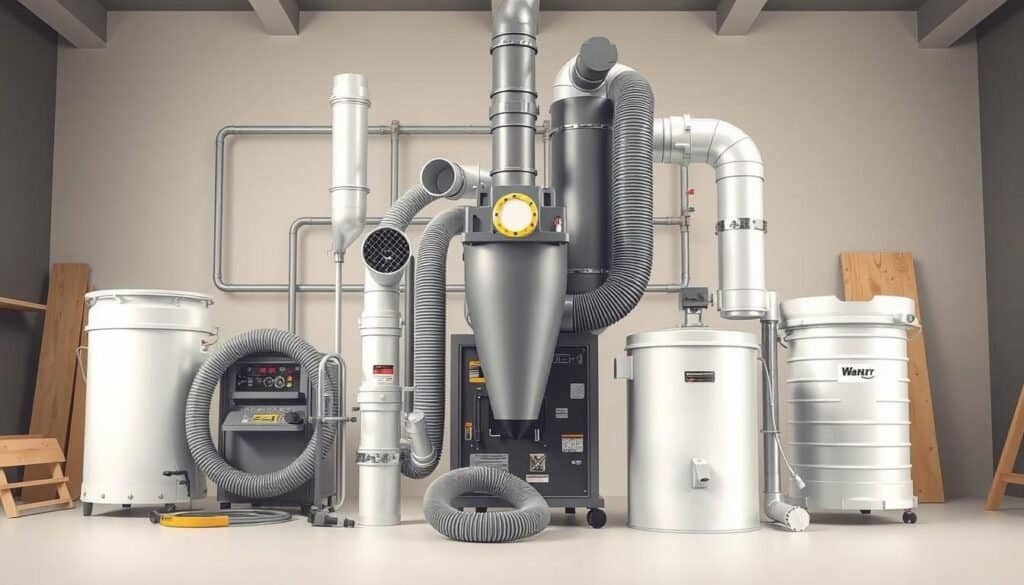
Fittings and adapters are also key. They connect ducting to tools and the collector, making sure there are no leaks. The right fittings boost the system’s efficiency.
Other important parts include clamps, hangers, and gates. Clamps hold ducting in place, and hangers stop it from sagging. Gates help isolate parts of the system for easier upkeep.
Accessories like sawhorses can also improve a dust collection system. Sturdy sawhorses with clamps keep workpieces steady, cutting down on dust. Using sawhorse plans can help find or make the right ones.
Guides for tools, like Dremel bits, are also helpful. They teach users how to use and care for their tools, which can lower dust output.
Choosing and using these essential parts makes a dust collection system work well. It keeps your workshop clean and safe.
How to Set Up a Dust Collection System in Your Shop: Step-by-Step Installation
To keep your workshop safe and dust-free, follow this guide. A dust collection system can greatly improve air quality and safety.
Start by planning your dust collection system’s layout. Think about your tools and machinery’s locations. Also, plan the ductwork’s path. Straight ducts are best for good airflow.
Then, gather the needed parts like the dust collector, ductwork, and fittings. Make sure everything fits your needs.
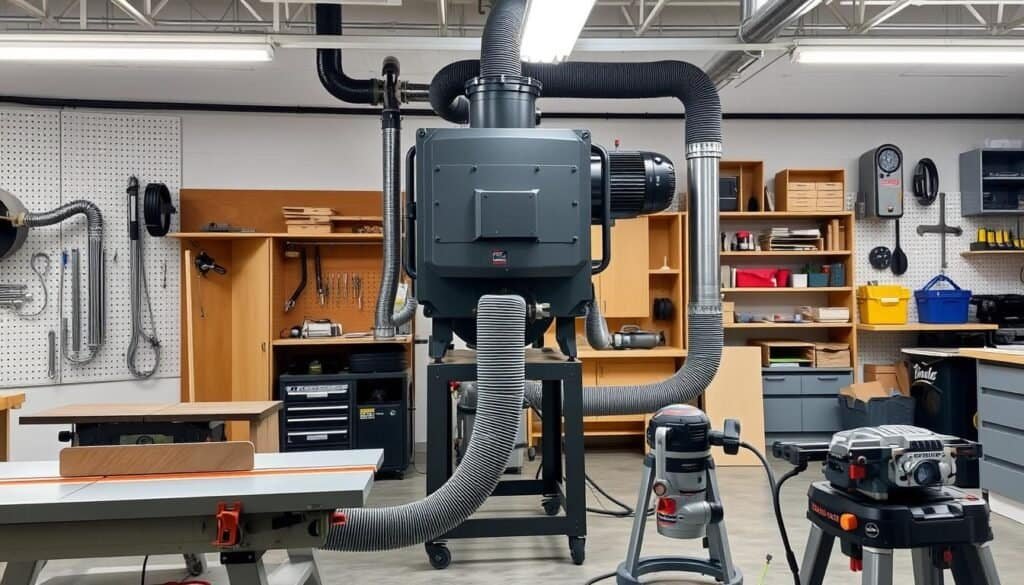
Mount the dust collector in a central spot in your workshop. Next, connect the ductwork to each tool. Secure it to the ceiling or walls.
Ensuring Proper Grounding for Safety
Grounding is key for your dust collection system’s safety. Make sure all metal parts are grounded to avoid static electricity.
To ground, connect a wire to a metal rod in the earth or a grounded conduit. Check that the connection is tight and follows local codes.
Test your dust collection system to see if it works well. Look for ductwork leaks and check tool connections. This ensures everything is running smoothly.
By following these steps and grounding correctly, you’ll have a great dust collection system. It will improve air quality and safety in your workshop. This is a smart tool hack for a safer, more efficient workshop.
Optimizing Airflow for Maximum Dust Collection Efficiency
Getting the airflow right is key for any dust collection system in your workshop. A good system improves air quality and boosts safety and productivity. It makes your handyman projects better.
To get the most out of your system, cut down on airflow losses. Make sure all connections and ducts are sealed and the right size. Leaks or small ducts can really hurt your system’s performance.
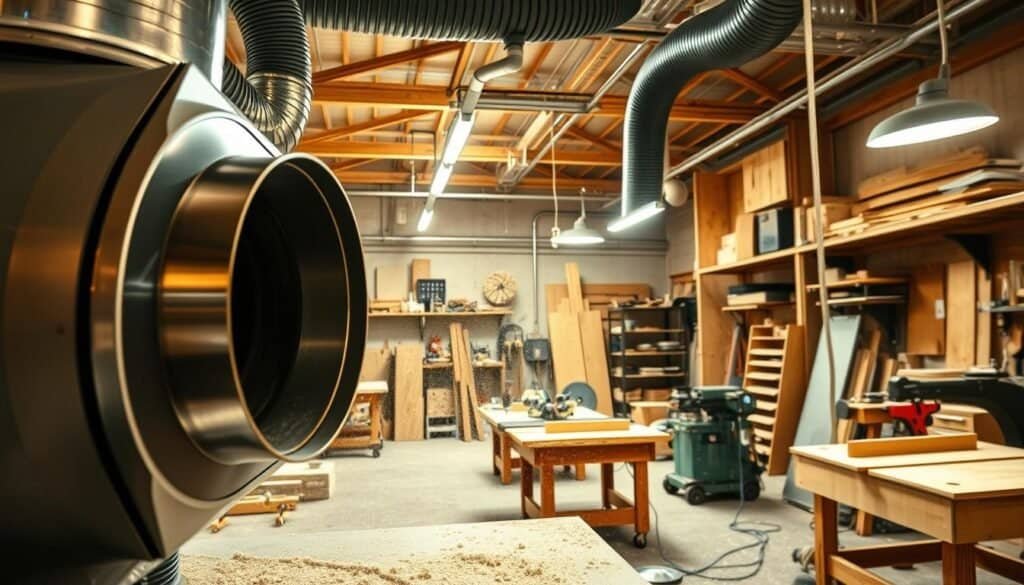
The design of your dust collection system matters a lot. Plan it so it has few bends and no big blocks. Using dust bin ideas that are easy to empty and clean helps too.
Don’t forget about regular upkeep. Check for blockages, clean filters, and make sure everything works well. With good airflow, your system will work better. This makes your workshop healthier and more productive for your projects.
Tool-Specific Dust Collection Solutions
Tool-specific dust collection solutions are key to keeping your DIY workshop clean and productive. Different tools make different kinds of dust. So, you need different ways to collect it effectively.
For table saws, a special dust collection system can be attached to the saw’s dust port. This cuts down airborne dust a lot. Also, for sanding, a dust collector can be hooked up to the sander. It catches dust right where it’s made.
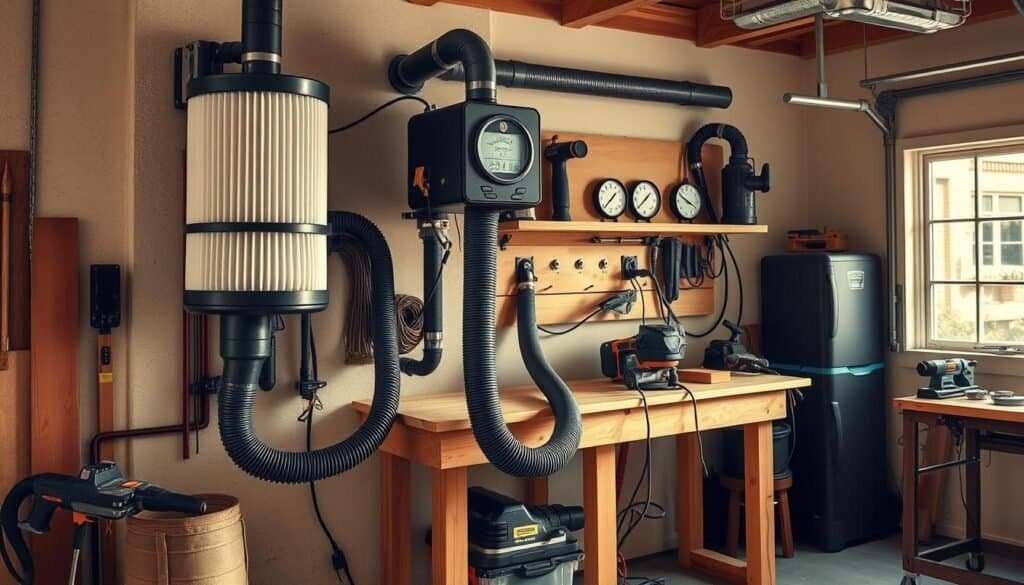
Adding DIY storage ideas to your workshop can also help with dust collection. For example, building a dust collection unit with storage for tools and accessories. This keeps your workshop tidy and free of clutter.
Setting up a DIY garage workshop vacuum station is another smart move. It involves a central vacuum unit with ports and hoses for different tools. This makes dust collection flexible and efficient.
By using tool-specific dust collection and DIY storage, you can make your workshop much cleaner and more productive.
DIY Workshop Dust Collection Enhancements
Improving your workshop’s dust collection system is easy with DIY projects. Organizing your garage tools and creating a vacuum station are key steps. They help make your dust collection system more efficient.
Keeping your tools organized is vital for a well-functioning workshop. It helps improve airflow and cuts down on dust. Begin by sorting your tools into categories and setting aside a spot for each group. This makes your dust collection system work better and saves you time finding tools.
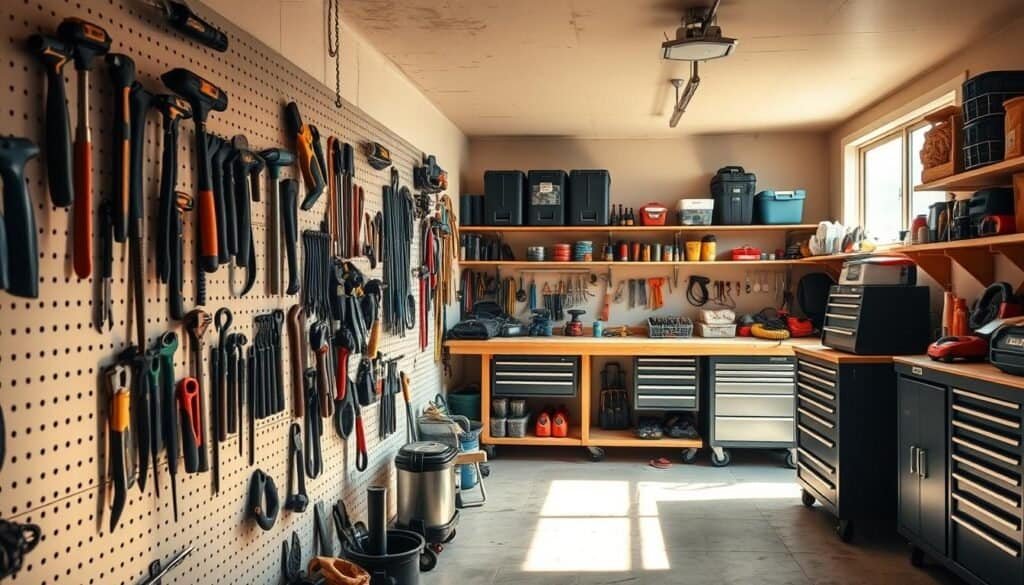
Building a vacuum station is another great way to boost your workshop’s dust collection. It gives you a central spot to connect your tools to the dust system. You’ll need PVC pipes, fittings, and a vacuum hose for this. With a simple DIY guide, you can make a vacuum station that fits your workshop’s needs.
These DIY improvements will greatly enhance your workshop’s dust collection. They make your workspace cleaner and healthier. Plus, you’ll work more efficiently and effectively.
Dust Collection System Maintenance and Care
Keeping your dust collection system in good shape is key for a safe woodworking workshop. Regular upkeep makes sure it works well and lasts longer. It’s important to check and clean the filters often. Dirty filters can make the system less effective, leading to more dust in the workshop.
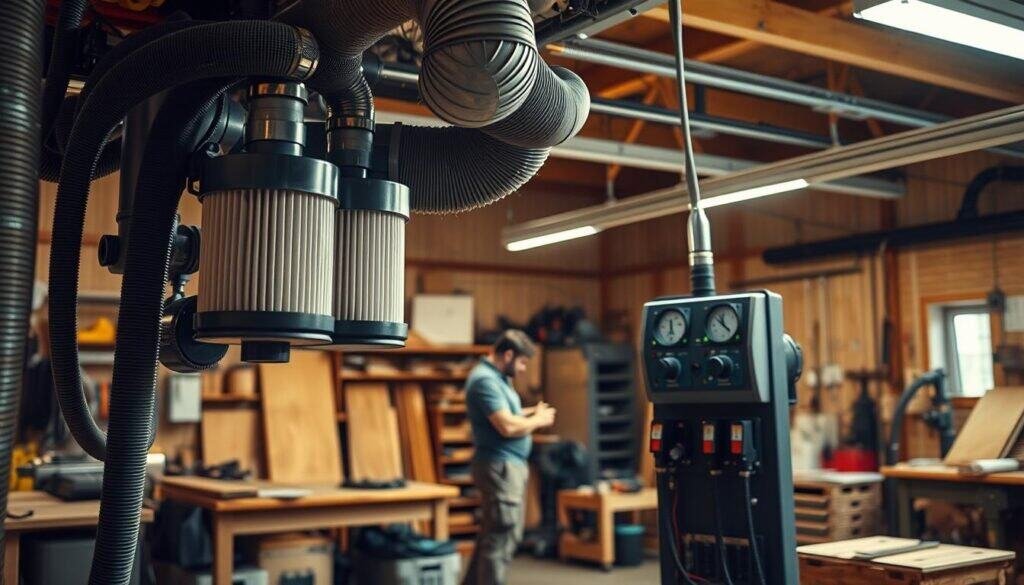
Also, check the ductwork for blockages or leaks. Leaks can make the system lose suction power, reducing its ability to catch dust. Make sure all connections are tight and there are no kinks or blockages in the ducts for best results.
Don’t forget to empty the dust collection bin regularly. A full bin can make the system less effective at catching dust. If it has a filter that can’t handle wet dust, it might get damaged. Always follow the manufacturer’s maintenance guidelines, including when to clean or replace filters.
By following these tips and keeping your system in check, you’ll have a cleaner, safer workspace. Maintenance isn’t just about keeping equipment running. It’s about making a healthier environment for everyone in the shop.
Troubleshooting Common Dust Collection Problems
Fixing your dust collection system might seem hard, but it’s key for good performance. A well-made dust collection system keeps your workspace clean and safe. It follows the best dust collection practices.
One big problem is less airflow. This can happen if filters get clogged or if ducts are the wrong size. Cleaning filters often and making sure ducts fit right helps a lot.
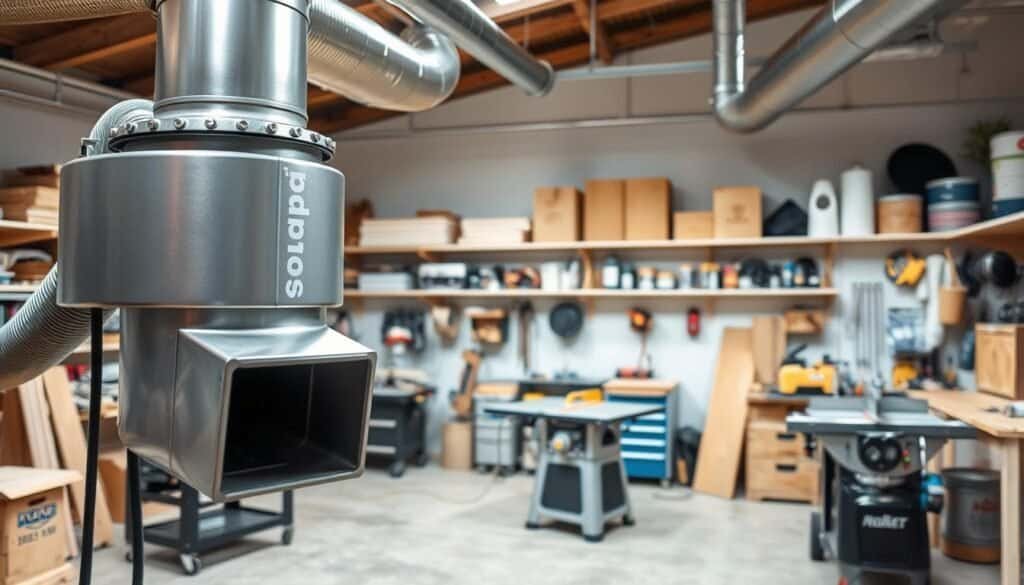
Leaks in ducts are another big issue. They make your dust collection system less effective. Check ducts for damage or gaps and seal them up. Also, make sure all connections are tight and sealed.
Clogged or blocked ducts are common too. Check ducts for blockages and clear them out when needed. Having a regular maintenance plan helps catch and fix problems early. This follows diy shop dust collection best practices.
By fixing these common problems, your dust collection system will work better. This keeps your workshop safer and healthier.
Upgrading Your Shop Dust Collection System
As your workshop grows, it’s key to upgrade your dust collection system. This keeps your workspace safe and efficient. First, check how well your current system works. Look at its airflow, filter, and ductwork to see if they’re up to date.
Good dust management cuts down on dust dangers and boosts work speed. When you upgrade, pick the right dust collector for your space. A single-stage or two-stage collector can make a big difference in how well you collect dust.
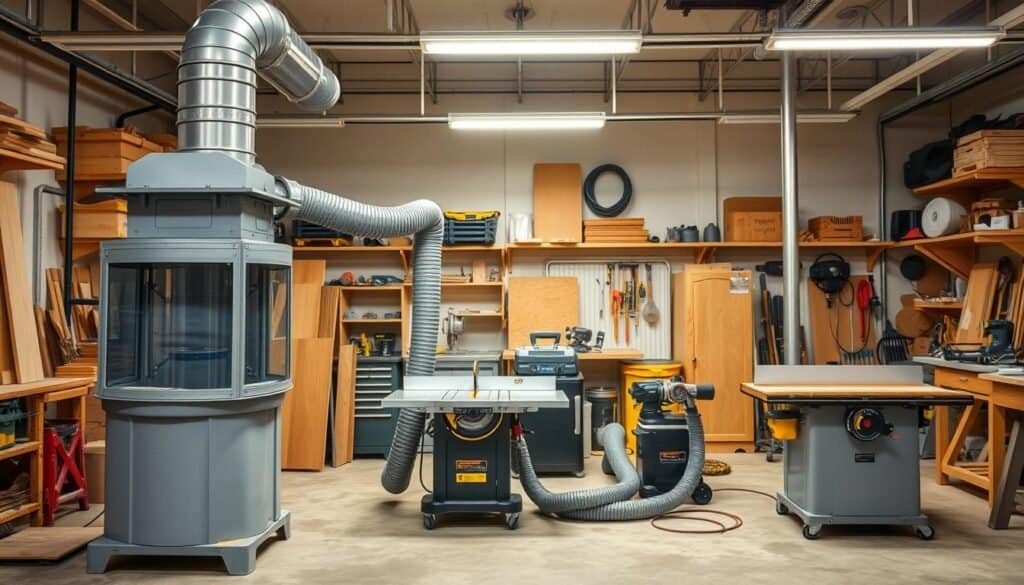
Improving your dust system means better ductwork and tool connections. You might need to change the duct layout or add new parts. Following the right steps ensures your system works its best.
Upgrading your dust system makes your workshop safer and more efficient. Keep it in top shape with regular checks and maintenance. This way, your system will always meet your changing needs.
Conclusion
A good dust collection system is key for a safe woodworking space. By following the steps in this article, you can set up a system that reduces wood dust risks.
Think about your shop’s needs and tools when setting up. Whether using homemade or commercial tools, a well-installed system keeps your space clean and safe.
Keep your system in top shape by checking for clogs and cleaning filters. Regular maintenance ensures your system works well, making woodworking safer and more fun.
With the knowledge from this article, you can make your woodworking area safer and healthier. Start setting up a dust collection system today and enjoy a cleaner, safer workspace.


